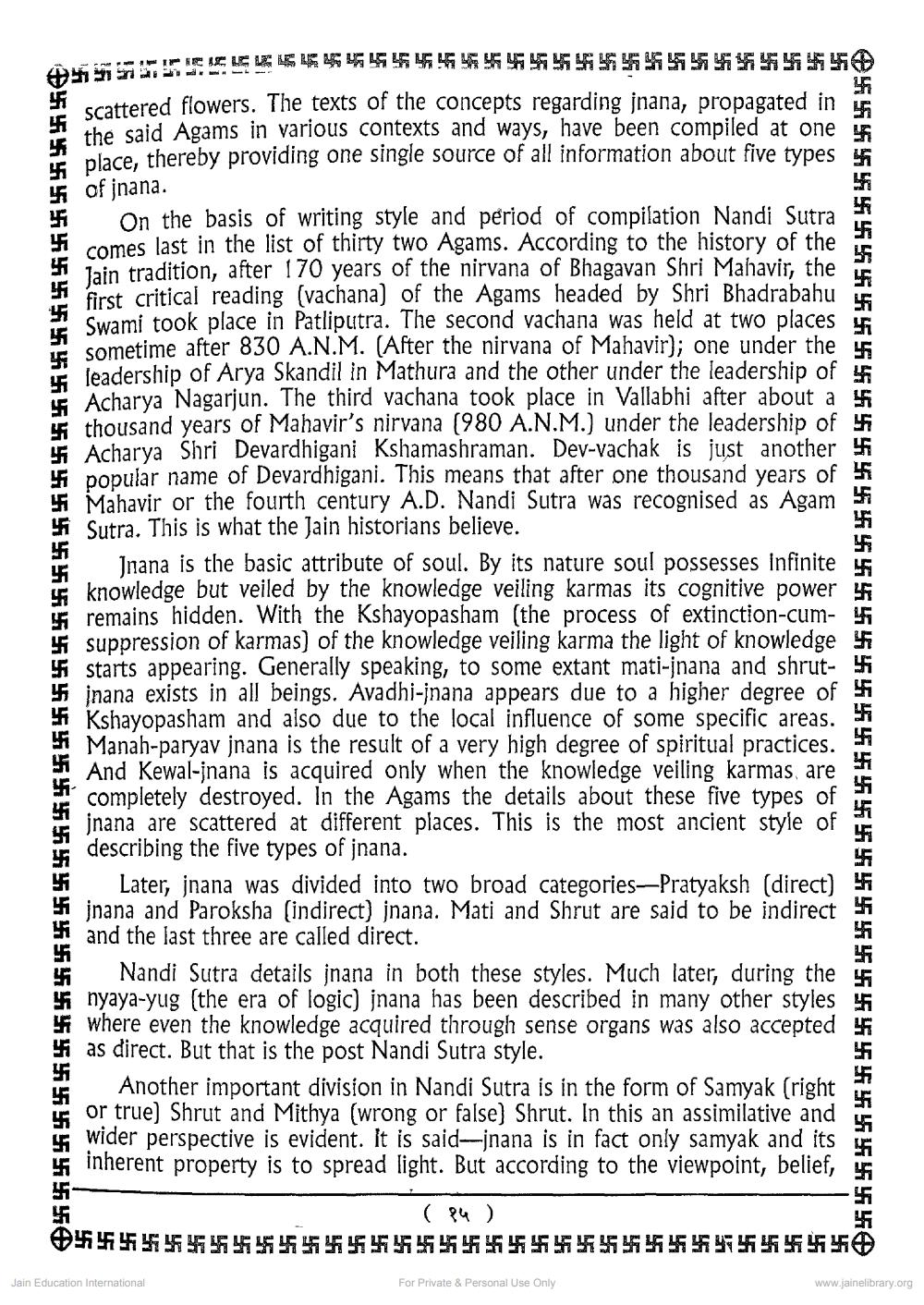________________
生听听听听听听听听听听听听听听听 听听听听听听听听听听听听
--CASCLE LEVEL 46 45 44 4 5 46 451555 970 scattered flowers. The texts of the concepts regarding jnana, propagated in En the said Agams in various contexts and ways, have been compiled at one
place, thereby providing one single source of all information about five types of jnana. On the basis of writing style and period of compilation Nandi Sutra
in the list of thirty two Agams. According to the history of the lain tradition, after 170 years of the nirvana of Bhagavan Shri Mahavir, the first critical reading (vachana) of the Agams headed by Shri Bhadrabahu Swami took place in Patliputra. The second vachana was held at two places sometime after 830 A.N.M. (After the nirvana of Mahavir); one under the
leadership of Arya Skandil in Mathura and the other under the leadership of C Acharya Nagarjun. The third vachana took place in Vallabhi after about a 4 " thousand years of Mahavir's nirvana (980 A.N.M.) under the leadership of 4 Acharya Shri Devardhigani Kshamashraman. Dev-vachak is just another Li popular name of Devardhigani. This means that after one thousand years of
Mahavir or the fourth century A.D. Nandi Sutra was recognised as Agam Hi Sutra. This is what the Jain historians believe.
Jnana is the basic attribute of soul. By its nature soul possesses infinite knowledge but veiled by the knowledge veiling karmas its cognitive power 45
remains hidden. With the Kshayopasham (the process of extinction-cum- 41 15 suppression of karmas) of the knowledge veiling karma the light of knowledge
starts appearing. Generally speaking, to some extant mati-inana and shrut
inana exists in all beings. Avadhi-jnana appears due to a higher degree of 4 Kshayopasham and also due to the local influence of some specific areas. Hi Manah-paryav jnana is the result of a very high degree of spiritual practices.
And Kewal-jnana is acquired only when the knowledge veiling karmas, are completely destroyed. In the Agams the details about these five types of jnana are scattered at different places. This is the most ancient style of
describing the five types of jnana. 4. Later, jnana was divided into two broad categories—Pratyaksh (direct)
jnana and Paroksha (indirect) jnana. Mati and Shrut are said to be indirect Ei and the last three are called direct. 1 Nandi Sutra details jnana in both these styles. Much later, during the
i nyaya-yug (the era of logic) jnana has been described in many other styles ! where even the knowledge acquired through sense organs was also accepted 4 41 as direct. But that is the post Nandi Sutra style.
Another important division in Nandi Sutra is in the form of Samyak (right or true) Shrut and Mithya (wrong or false) Shrut. In this an assimilative and 55 wider perspective is evident. It is said-jnana is in fact only samyak and its en 4 inherent property is to spread light. But according to the viewpoint, belief,
全听听听 5听听听听FFFF$听听听听听听听听听 听听听听听听听听玩听听听听听听听听听听听听听听听听听
i$$$$$$$$乐听听听听听斯
(84) 中班牙牙牙牙牙牙助步步55岁岁岁岁岁男明助听听听听听听中
Jain Education International
For Private & Personal Use Only
www.jainelibrary.org




